农业经济学Agricultural Economy
- 格式:ppt
- 大小:3.43 MB
- 文档页数:36
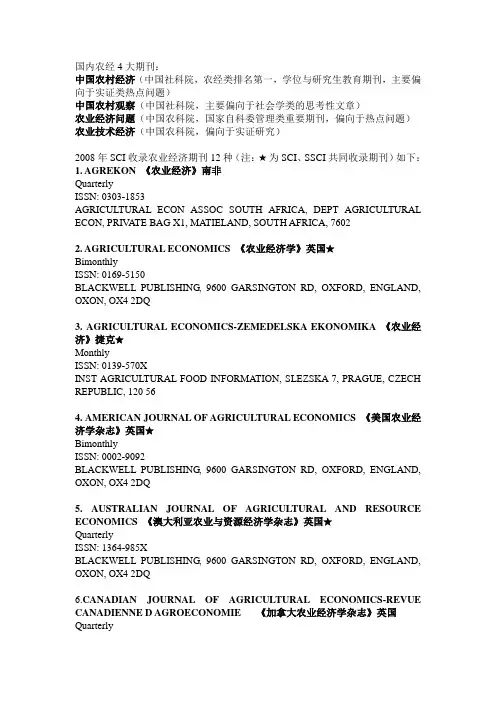
国内农经4大期刊:中国农村经济(中国社科院,农经类排名第一,学位与研究生教育期刊,主要偏向于实证类热点问题)中国农村观察(中国社科院,主要偏向于社会学类的思考性文章)农业经济问题(中国农科院,国家自科委管理类重要期刊,偏向于热点问题)农业技术经济(中国农科院,偏向于实证研究)2008年SCI收录农业经济期刊12种(注:★为SCI、SSCI共同收录期刊)如下:1. AGREKON 《农业经济》南非QuarterlyISSN: 0303-1853AGRICULTURAL ECON ASSOC SOUTH AFRICA, DEPT AGRICULTURAL ECON, PRIV ATE BAG X1, MATIELAND, SOUTH AFRICA, 76022. AGRICULTURAL ECONOMICS 《农业经济学》英国★BimonthlyISSN: 0169-5150BLACKWELL PUBLISHING, 9600 GARSINGTON RD, OXFORD, ENGLAND, OXON, OX4 2DQ3. AGRICULTURAL ECONOMICS-ZEMEDELSKA EKONOMIKA 《农业经济》捷克★MonthlyISSN: 0139-570XINST AGRICULTURAL FOOD INFORMATION, SLEZSKA 7, PRAGUE, CZECH REPUBLIC, 120 564. AMERICAN JOURNAL OF AGRICULTURAL ECONOMICS 《美国农业经济学杂志》英国★BimonthlyISSN: 0002-9092BLACKWELL PUBLISHING, 9600 GARSINGTON RD, OXFORD, ENGLAND, OXON, OX4 2DQ5. AUSTRALIAN JOURNAL OF AGRICULTURAL AND RESOURCE ECONOMICS 《澳大利亚农业与资源经济学杂志》英国★QuarterlyISSN: 1364-985XBLACKWELL PUBLISHING, 9600 GARSINGTON RD, OXFORD, ENGLAND, OXON, OX4 2DQ6.CANADIAN JOURNAL OF AGRICULTURAL ECONOMICS-REVUE CANADIENNE D AGROECONOMIE 《加拿大农业经济学杂志》英国QuarterlyISSN: 0008-3976BLACKWELL PUBLISHING, 9600 GARSINGTON RD, OXFORD, ENGLAND, OXON, OX4 2DQ7. EUROPEAN REVIEW OF AGRICULTURAL ECONOMICS 《欧洲农业经济评论》英国★QuarterlyISSN: 0165-1587OXFORD UNIV PRESS, GREAT CLARENDON ST, OXFORD, ENGLAND, OX2 6DP8. FOOD POLICY 《粮食政策》英国★BimonthlyISSN: 0306-9192ELSEVIER SCI LTD, THE BOULEV ARD, LANGFORD LANE, KIDLINGTON, OXFORD, ENGLAND, OXON, OX5 1GB9. ITEA-INFORMACION TECNICA ECONOMICA AGRARIA 《农业经济信息技术》西班牙QuarterlyISSN: 1699-6887ASOCIACION INTERPROFESIONAL DESARROLLO AGARIO, A VDA MONTANANA 930, APARTADO 727, ZARAGOZA, SPAIN, 5008010. JOURNAL OF AGRICULTURAL AND RESOURCE ECONOMICS《农业与资源经济学杂志》美国★Tri-annualISSN: 0162-1912WESTERN AGRICULTURAL ECONOMICS ASSOC, C/O DEEVON BAILEY, UTAH STATE UNIV, ECONOMICS DEPT, 3535 OLD MAIN HILL, LOGAN, USA, UT, 84322-353011. JOURNAL OF AGRICULTURAL ECONOMICS《农业经济学杂志》英国★Tri-annualISSN: 0021-857XBLACKWELL PUBLISHING, 9600 GARSINGTON RD, OXFORD, ENGLAND, OXON, OX4 2DQ12. REVIEW OF AGRICULTURAL ECONOMICS 《农业经济学评论》英国★SemiannualISSN: 1058-7195BLACKWELL PUBLISHING, 9600 GARSINGTON RD, OXFORD, ENGLAND, OXON, OX4 2DQ。
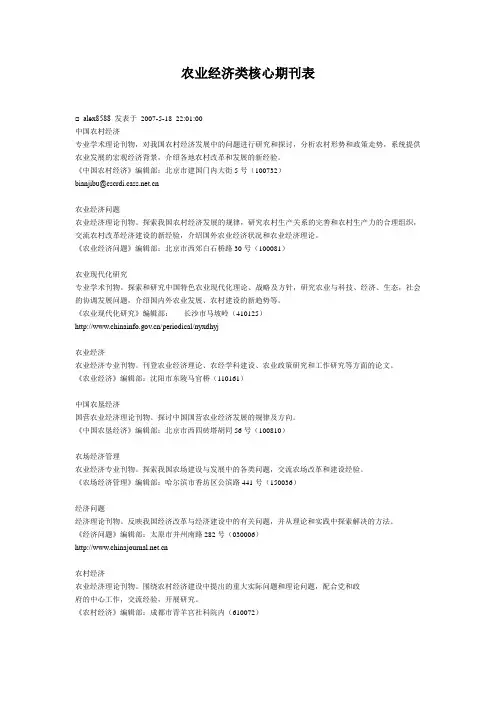
农业经济类核心期刊表□ alex8588 发表于2007-5-18 22:01:00中国农村经济专业学术理论刊物,对我国农村经济发展中的问题进行研究和探讨,分析农村形势和政策走势,系统提供农业发展的宏观经济背景,介绍各地农村改革和发展的新经验。
《中国农村经济》编辑部:北京市建国门内大街5号(100732)bianjibu@农业经济问题农业经济理论刊物。
探索我国农村经济发展的规律,研究农村生产关系的完善和农村生产力的合理组织,交流农村改革经济建设的新经验,介绍国外农业经济状况和农业经济理论。
《农业经济问题》编辑部:北京市西郊白石桥路30号(100081)农业现代化研究专业学术刊物。
探索和研究中国特色农业现代化理论、战略及方针,研究农业与科技、经济、生态,社会的协调发展问题,介绍国内外农业发展、农村建设的新趋势等。
《农业现代化研究》编辑部:长沙市马坡岭(410125)/periodical/nyxdhyj农业经济农业经济专业刊物。
刊登农业经济理论、农经学科建设、农业政策研究和工作研究等方面的论文。
《农业经济》编辑部:沈阳市东陵马官桥(110161)中国农垦经济国营农业经济理论刊物。
探讨中国国营农业经济发展的规律及方向。
《中国农垦经济》编辑部:北京市西四砖塔胡同56号(100810)农场经济管理农业经济专业刊物。
探索我国农场建设与发展中的各类问题,交流农场改革和建设经验。
《农场经济管理》编辑部:哈尔滨市香坊区公滨路441号(150036)经济问题经济理论刊物。
反映我国经济改革与经济建设中的有关问题,并从理论和实践中探索解决的方法。
《经济问题》编辑部:太原市并州南路282号(030006)农村经济农业经济理论刊物。
围绕农村经济建设中提出的重大实际问题和理论问题,配合党和政府的中心工作,交流经验,开展研究。
《农村经济》编辑部:成都市青羊宫社科院内(610072)福建论坛经济社会版综合性学术刊物。
内容注重对有中国特色社会主义理论的研究,探讨改革开放中的重大经济问题、社会问题、海峡两岸经贸发展问题,特区发展问题及华侨问题等。
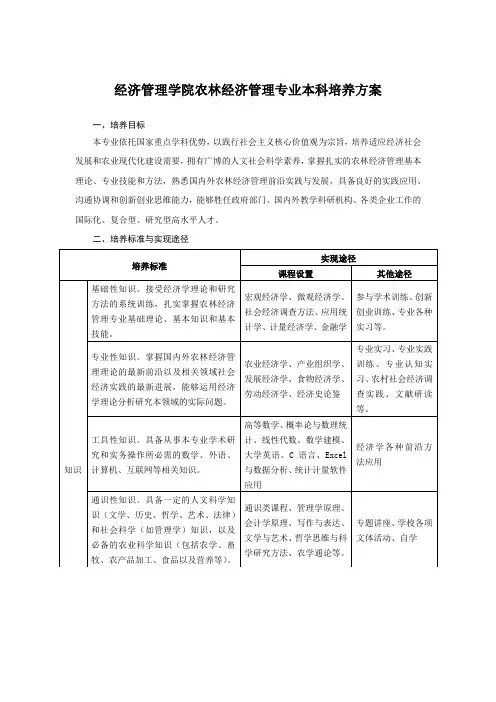
经济管理学院农林经济管理专业本科培养方案一、培养目标本专业依托国家重点学科优势,以践行社会主义核心价值观为宗旨,培养适应经济社会发展和农业现代化建设需要,拥有广博的人文社会科学素养,掌握扎实的农林经济管理基本理论、专业技能和方法,熟悉国内外农林经济管理前沿实践与发展,具备良好的实践应用、沟通协调和创新创业思维能力,能够胜任政府部门、国内外教学科研机构、各类企业工作的国际化、复合型、研究型高水平人才。
二、培养标准与实现途径三、主干学科(中英文对照):农林经济管理(Agricultural and Forestry Economics and Management)农业经济管理(Agricultural Economics and Management)四、核心课程宏观经济学A、微观经济学A、应用统计学、计量经济学、社会经济调查方法、金融学、农业经济学、产业组织学、食物经济学、发展经济学、专业综合实践训练。
五、学制与授予学位门类:学制:四年制本科,实行弹性学习年限;授予管理学学士学位。
六、毕业最低学分要求:课内:147.5;课外:4 ;其中理论课程学分: 124,实践环节学分: 23.5。
七、课程设置与修读要求1、通识教育: 59 学分1-2、大学外语: 8 学分大学英语课程分为读写、听说、人文素养和翻译四个模块(课程名单另附),本科生在校期间可根据自身需要,自主从四个模块中选修英语课程。
每学期限选2学分英语课程。
1-3、数学、物理、化学: 18 学分;1-4、计算机: 2 学分:本专业学生限选下列课程:1-5、体育:4学分学生在校期间至少取得4学分体育类课程,并须每年通过国家要求的体育达标测试。
学生根据本人身体条件,可以通过参加体育俱乐部、专项体育课、体疗课等取得体育学分。
学校安排达标测试的学期,学生如不参加测试,则不能取得该学期的体育课学分;未修读体育课的学期,学生参加并通过达标测试,可取得0.5学分。
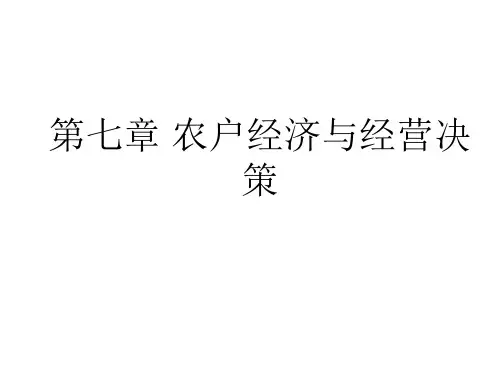

农业经济学课程思政教学模式构建与实践——以河北农业大学为例刘宇鹏董谦胡建戴芳(河北农业大学,河北保定071000)摘要本文以河北农业大学为例,在分析农业经济学课程性质的基础上,系统梳理了该课程内容和特点,并挖掘课程思政元素,结合国家“三农”政策法规,构建了微观—中观—宏观、课前—课中—课后、线上—线下经纬耦合的农业经济学课程思政教学模式,并探索出思政元素融入农业经济学课堂的有效实施路径,以期培养学生的综合能力。
关键词农业经济学;思政教学模式;实践探究;河北农业大学中图分类号G641文献标识码A文章编号1007-5739(2024)07-0217-04DOI:10.3969/j.issn.1007-5739.2024.07.053开放科学(资源服务)标识码(OSID):Construction of Ideological and Political Teaching Mode of Agricultural EconomicsCourse and Its Practice:Taking Hebei Agricultural University as an ExampleLIU Yupeng DONG Qian HU Jian DAI Fang(Hebei Agricultural University,Baoding Hebei071000)Abstract Taking Hebei Agricultural University as an example,based on the analysis of the nature of the agricul-tural economics course,this paper systematically sorted out the course content and characteristics,explored the ideolo-gical and political elements of the course,and combined the national policies and regulations on"agriculture,rural areas, and farmers"to construct a micro-meso-macro,before class-in class-after class,online-offline longitude-latitude coupled agricultural economics course ideological and political teaching model,and explored the effective implemen-tation path of integrating ideological and political elements into the classroom of agricultural economics,so as to cultivate students'comprehensive abilities.Keywords agricultural economics;ideological and political teaching mode;practical exploration;Hebei Agricul-tural University课程思政建设是大学专业教育的应有之义。
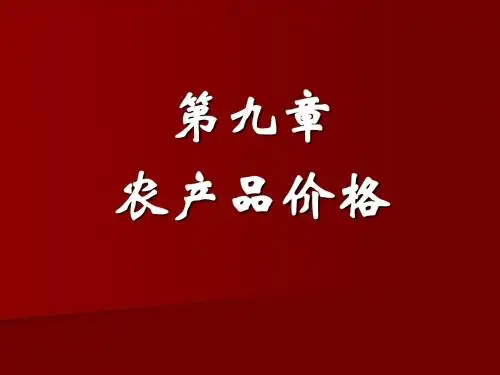

经济学顶级期刊介绍国内经济学核心期刊目录(CSSCI)1 经济研究2 改革3 会计研究4 经济社会体制比较5 中国工业经济6 国际经济评论7 经济学家8 经济学动态9 经济科学10 农业经济问题11 国际贸易问题12 中国农村经济13 金融研究14 世界经济15 中国农村观察16 财贸经济17 财政研究18 经济理论与经济管理19 世界经济研究20 数量经济技术经济研究21 财经研究22 当代经济研究(中国"资本论"研究会会刊)23 中国经济问题24 中国土地科学25 中国社会经济史研究26 中国经济史研究27 国际金融研究28 世界经济与政治29 南开经济研究30 国际贸易31 消费经济32 财经问题研究33 宏观经济研究34 当代经济科学35 当代财经36 经济评论37 投资研究38 国际经济合作39 经济问题40 税务研究41 上海经济研究42 城市发展研究43 中南财经大学学报44 亚太经济45 中国国情国力46 林业经济47 经济纵横48 世界经济文汇49 中国技术经济科学50 经济与管理研究51 生态经济52 国际经贸研究(现改名:南开管理评论)53 财经科学54 农业技术经济55 上海金融56 中国物价57 保险研究58 中国流通经济59 中国资产评估60 生产力研究61 金融科学62 中国投资与建设(改名:中国投资)63 港澳新经济64 对外经贸实务65 国际商务研究(上海对外贸易学院学报)66 经济问题探索67 审计研究68 经济与信息69 现代日本经济70 中央财经大学学报。
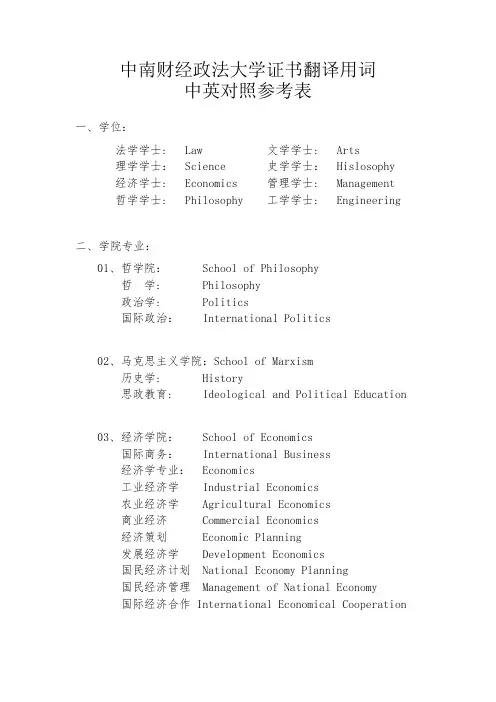
中南财经政法大学证书翻译用词中英对照参考表一、学位:法学学士: Law 文学学士: Arts理学学士: Science 史学学士: Hislosophy经济学士: Economics 管理学士: Management哲学学士: Philosophy 工学学士: Engineering二、学院专业:01、哲学院: School of Philosophy哲学: Philosophy政治学: Politics国际政治: International Politics02、马克思主义学院:School of Marxism历史学: History思政教育: Ideological and Political Education03、经济学院: School of Economics国际商务: International Business经济学专业: Economics工业经济学 Industrial Economics农业经济学 Agricultural Economics商业经济 Commercial Economics经济策划 Economic Planning发展经济学 Development Economics国民经济计划 National Economy Planning国民经济管理 Management of National Economy国际经济合作 International Economical Cooperation04、财政税务学院 School of Public Finance and Taxation财政学 Public Finance税务 Taxation农业税收 Agricultural Taxation国际税收 International Taxation注册税务师方向 Certified Tax Agents05、新华金融保险学院Xinhua School of Finance and Insurance金融学 Finance金融工程 Financial Engineering保险 Insurance统计学 Statistics工程管理 Engineering Management国际金融 International Finance国际贸易 International Trade投资学 Investments投资经济 Investment Economics国际投资 International Investment投资项目评估 Evaluation on Investment Project证券 Securities证券投资 Security Investment房地产经营管理Real estate Management理财学 Management of Financial Affairs货币银行学 Money and Banking农村金融与保险 Agricultural Finance and Insurance银行经营管理 Operation and Administration of Bank06、法学院 School of Law法学 Law经济法 Economic Law国际经济法 International Economic Law07、刑事司法学院 School of Criminal and Justice公安学院 School of Public Security侦查学 Investigation治安学 Public Security边防管理 Management of Border Defence08、外国语学院 School of Foreign Languages英语 English日语 Japanese09、新闻与文化传播学院School of Journalism and Mass Communication汉语言文学 Chinese Language and Literature新闻传播学 Journalism and Communication汉语与写作 Chinese and Writing艺术设计(动画方向) Art and Design (Animation)广电新闻学 Journalism of Broadcasting and Television10、工商管理学院 School of Business Administration工商管理 Business Administration工程管理 Engineering Management物流管理 Logistics Management市场营销 Marketing国际经济与贸易 International Economics and Trade国际贸易 International Trade贸易经济 Trade and Economic商贸英语 Business English人力资源管理 Management of Human Resources电子商务 Electronic Commerce管理科学 Science of Administration.旅游管理 Tourism Management农林经济管理:Management of Agricultural and Forestry Economy国际企业管理Management of International Enterprises11、会计学院 School of Accounting财务管理 Financial Management会计学 Accounting国际会计 International Accounting注册会计师 Certified Public Accountant12、公共管理学院 School of Public Administration劳动与社会保障 Labor and Social Security行政管理 General Administration公共关系学 Public Relation劳动人事管理 Personnel Administration公共事业管理 Management of Public Affairs国有资产管理 Management of Stated-Owned Assets城市管理 Urban Management13、统计与数学学院 School of Statistics and Mathematics统计学 Statistics信息与计算科学 Information and Calculate Science14、信息与安全工程学院School of Information and Safety Engineering安全工程 Safety Engineering环境工程 Environmental Engineering计算机应用 Application of Computer电子商务(信息技术方向) Electronic Commerce计算机科学与技术 Computer Science and Technology数据库系统 Data Base System管理信息系统Managerial Information System信息管理与信息系统Information Management and Information System。
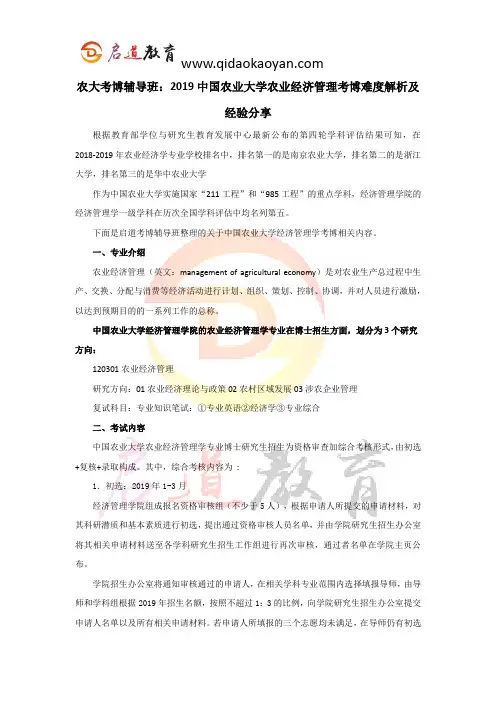
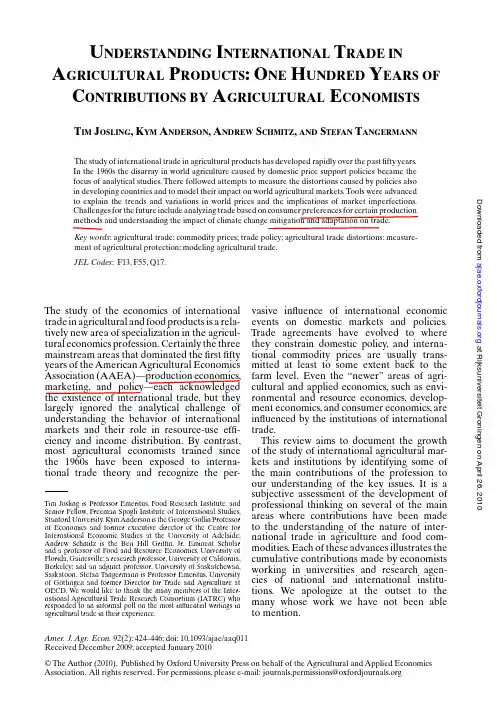
U NDERSTANDING I NTERNATIONAL T RADE INA GRICULTURAL P RODUCTS:O NE H UNDRED Y EARS OFC ONTRIBUTIONS BY A GRICULTURAL E CONOMISTST IM J OSLING,K YM A NDERSON,A NDREW S CHMITZ,AND S TEFAN T ANGERMANNThe study of international trade in agricultural products has developed rapidly over the pastfifty years.In the1960s the disarray in world agriculture caused by domestic price support policies became thefocus of analytical studies.There followed attempts to measure the distortions caused by policies alsoin developing countries and to model their impact on world agricultural markets.Tools were advancedto explain the trends and variations in world prices and the implications of market imperfections.Challenges for the future include analyzing trade based on consumer preferences for certain productionmethods and understanding the impact of climate change mitigation and adaptation on trade.Key words:agricultural trade;commodity prices;trade policy;agricultural trade distortions;measure-ment of agricultural protection;modeling agricultural trade.JEL Codes:F13,F55,Q17.The study of the economics of international trade in agricultural and food products is a rela-tively new area of specialization in the agricul-tural economics profession.Certainly the three mainstream areas that dominated thefirstfifty years of the American Agricultural Economics Association(AAEA)—production economics, marketing,and policy—each acknowledged the existence of international trade,but they largely ignored the analytical challenge of understanding the behavior of international markets and their role in resource-use effi-ciency and income distribution.By contrast, most agricultural economists trained since the1960s have been exposed to interna-tional trade theory and recognize the per-Tim Josling is Professor Emeritus,Food Research Institute,and Senior Fellow,Freeman Spogli Institute of International Studies, Stanford University.Kym Anderson is the George Gollin Professor of Economics and former executive director of the Centre for International Economic Studies at the University of Adelaide; Andrew Schmitz is the Ben Hill Griffin,Jr.Eminent Scholar and a professor of Food and Resource Economics,University of Florida,Gainesville;a research professor,University of California, Berkeley;and an adjunct professor,University of Saskatchewan, Saskatoon.Stefan Tangermann is Professor Emeritus,University of Göttingen and former Director for Trade and Agriculture at OECD.We would like to thank the many members of the Inter-national Agricultural Trade Research Consortium(IATRC)who responded to an informal poll on the most influential writings in agricultural trade in their experience.vasive influence of international economic events on domestic markets and policies. Trade agreements have evolved to where they constrain domestic policy,and interna-tional commodity prices are usually trans-mitted at least to some extent back to the farm level.Even the“newer”areas of agri-cultural and applied economics,such as envi-ronmental and resource economics,develop-ment economics,and consumer economics,are influenced by the institutions of international trade.This review aims to document the growth of the study of international agricultural mar-kets and institutions by identifying some of the main contributions of the profession to our understanding of the key issues.It is a subjective assessment of the development of professional thinking on several of the main areas where contributions have been made to the understanding of the nature of inter-national trade in agriculture and food com-modities.Each of these advances illustrates the cumulative contributions made by economists working in universities and research agen-cies of national and international institu-tions.We apologize at the outset to the many whose work we have not been able to mention.Amer.J.Agr.Econ.92(2):424–446;doi:10.1093/ajae/aaq011Received December2009;accepted January2010©The Author(2010).Published by Oxford University Press on behalf of the Agricultural and Applied Economics Association.All rights reserved.For permissions,please e-mail:journals.permissions@ at Rijksuniversiteit Groningen on April 26, Downloaded fromJosling et al.Understanding International Trade in Agricultural Products425Changing Trade Issues over the Past Ten DecadesAgricultural economists,by the nature of their discipline,are attracted to the issues of the day. It follows that those who work on international trade issues in the main respond to emerg-ing trade situations that demand analysis and explanation.Theoretical developments and improvements in analytical technique often accompany these attempts to understand and explain current problems.As a backdrop to the more detailed discussion of the contributions of economists to the study of international agri-cultural trade,we therefore begin by tracing the evolution of trade issues over the100years since the founding of theAAEA.This will illus-trate the tumultuous nature of the changes that have called out to be addressed by economists, as well as the dramatic advances in theoretical and analytical tools that have been developed to understand these issues.Agricultural trade historically has been a significant share of total commerce,and for many countries has played a dominant role in determining foreign policy.As late as1890, agricultural exports accounted for75%of the total exports from the United States(Johnson 1977,p.298).By the time the AAEA came into existence in1909,the export share was about 50%,and that share fell steadily until the1940s before reviving in the immediate postwar era to about20%.For the world as a whole,agri-cultural trade has steadily declined as a share of total trade in goods and services and is now less than8%,even though it has been increas-ing faster than world agricultural production. Yet trade in agricultural products remains very important for both high-income and develop-ing countries,and agricultural trade policies typically are among the most sensitive in any international trade negotiations.Thefirst two decades of the AAEA,from 1909to1929,was a period of steady decline in trade from the high point of the nineteenth-century globalization period to the growth of protectionist movements and the collapse of European empires in the devastation of World War I.Though the founding fathers of the AAEA were well aware of the geopol-itics of the period and the impact on agri-cultural tradeflows,few books or articles by agricultural economists stand out as dealing systematically with trade issues during that ernment intervention in agricul-tural markets was not on the horizon,and agricultural tariffs were generally low relative to barriers to trade in manufactured goods and services.During the1920s,the situation began to change.With domestic farm policy emergingas a way to boost rural incomes,pressure grewto use trade policy as part of the strategy.The McNary-Haughen Act was an early attemptto use trade policy to influence domestic mar-kets,and the same trend toward protectionismwas occurring in other countries.1The book by Edwin Nourse(1924)introduced a more holis-tic view of world markets as well as a cogent explanation of their significance for U.S.agri-culture.At this time,trade theorists began to expand on the determinants of trade,and thesignificance of resource endowments emergedas a major factor in the explanation of tradeflows.By the third decade of the AAEA’s exis-tence,trade policy was a matter of high polit-ical interest and international contention.TheGreat Depression was widespread and pro-tracted in part because of increased trade pro-tection,and agricultural trade was not spared.The1930Smoot-Hawley tariff bill was origi-nally designed as an agricultural tariff increasebut ended up more generally applied to all goods.Did the profession sit idly by while theworld trade system disintegrated and economic autarchy reigned?It is not easy tofind sem-inal articles from this period on agriculturaltrade and the collapse of markets,with the notable exception of T.W.Schultz’s,who wroteon world agricultural trade and the serious implications for U.S.markets(Schultz1935).The fourth decade was not one of major contributions to the agricultural economics lit-erature in the area of trade.Wartime condi-tions were not conducive to academic pursuits,since many members of the profession wereco-opted into government posts and presum-ably made contributions that may never be revealed.2However,the postwar trading sys-tem was being constructed in the1940s,and agricultural issues were often at the heart of the discussion.3The debates between such notable economists as James Meade and Keynes and1Agricultural economists commented on these issues,in the con-texts of both domestic policy and the trade system.Afine exampleis the study by Black(1928),who warned of the consequences ofthis policy.2An exception was Henry C.Taylor’s book on world agriculturaltrade,emphasizing the importance of the European market(Taylorand Taylor1943).3The debate on managing commodity markets is an example;see the discussion below of the writings by Davis(1942)and Tsouand Black(1944).at Rijksuniversiteit Groningen on April 26, Downloaded from426April2010Amer.J.Agr.Econ.their American counterparts explicitly dealt with the inclusion of agricultural trade in the postwar system but were notable for their assumption that these issues were of such a high political importance that the arguments for freer markets were unlikely to prevail.Mean-while the theory of international trade took major steps forward:Samuelson’s(1948)arti-cle on factor price equalization appeared,and the basis was laid for modern trade theory. The decade of the1950s saw the start of a serious professional interest in agricultural and commodity trade.D.Gale Johnson published a book on the inconsistency between U.S.trade and agricultural policies:the one advocating open markets,the other maintaining protec-tive barriers(Johnson1950).For twenty years Johnson refined this message and had a pro-found impact on the profession(if not on policy),as is detailed below.Condliffe(1951) included some insightful comments about agri-cultural trade in his book The Commerce of Nations,in addition to showing the complexi-ties of trade regulations at that time(Condliffe 1951).4The link between commodity trade and economic development and growth also began to be considered during this period.In fact this was the start of development economics as the colonial system disintegrated.Even the begin-nings of the political economy of agricultural trade can be traced to this period.Kindleberger (1951)introduced interest-group analysis into the explanation of national tariff policies,set-ting the stage for later political economy work on agricultural trade.By the start of the1960s the issue of agri-cultural commodity trade became a significant international concern.The1960s saw sharp increases in agricultural protection in indus-trial countries.The trade system staggered under the burden of the disposition of sur-pluses built up under high price supports. Developing countries saw a different side of this with their requests for market access(on concessional terms)rebuffed by strong domes-tic political forces and their export earnings depressed by low commodity prices in interna-tional markets.Much of the professional writ-ing in the United States on agricultural trade in 4Condliffe influenced a generation of students at Berkeley, including Hillman,who began to ask systematic questions about the issues facing agricultural trade.Hillman(1996)shows some frus-tration over the lack of earlier studies on trade,declaring:“[A]bout the only works relating to agricultural trade were a1920s book by Nourse and Gale Johnson’s work on the trade policy dilemma of US agriculture.”this period focused on how to increase exports,either commercially or through food aid.The1960s saw another development thathas had a profound impact on agricultural trade:the rebirth of regional economic integra-tion and somewhat less ambitious free trade areas.European economists,as well as theirNorth American counterparts,were intriguedby the bold experiment of the European Eco-nomic Community(EEC)but were concernedabout the protectionist Common AgriculturalPolicy(CAP)that formed an integral partof the agreement.The tensions between theEEC(later the EU)and the United Statesover agricultural trade were a major theme for economists during this period and indeed untilthe mid-1990s,when the World Trade Orga-nization(WTO)internalized some of theseconflicts.Both trade theory and the theory of eco-nomic integration were developing rapidly,asreal-world events challenged accepted expla-nations.In the1960s,trade theorists paid increasing attention to international capital movements within the context of standardtrade theory:Capital movements could be a substitute for product trade.5Agricultural eco-nomics as a whole stuck close to its microeco-nomic roots and to a“closed economy”viewof the agricultural sector.There was still a dis-connect between the teaching of agricultural marketing and domestic policy on the one handand teaching about the functioning of the inter-national trade and monetary system on the other.This meant that the profession was some-what slow in responding to the emerging tradeissues of the1960s.6By the1970s a host of new issues had arisenwhich emphasized the importance of external economic events.A sharp rise in oil prices, together with droughts in India,Africa,and the USSR,caused agricultural commodity marketsto spike upward.Two devaluations of the dollar5Schmitz and Helmberger(1970)then developed a modelin which they demonstrate that capital movements and producttrade can be complements,in that increased capital movementsbring about increased product trade.Their examples chosen werefor agriculture and natural resource industries and presaged thegrowth of agricultural and food trade linked to foreign direct investment that has continued to this day.6In an editorial introduction to the otherwise impressive col-lection of articles on agricultural economics published by theAmerican Economics Association(AEA)in1969,the editorsadmit that the“decision to emphasize a limited number of topicsresulted in the exclusion of a number of areas in which agricultural economists have specialized.Among the more importantfields thathave been excluded[is]...international trade”(AEA1969,p.xvi).D.Gale Johnson was on the selection committee for this volume,so presumably he found inadequate material in this area to include.at Rijksuniversiteit Groningen on April 26, Downloaded fromJosling et al.Understanding International Trade in Agricultural Products427and the virtual abandonment of the Bretton Woods monetary system added more shocks to markets.Increased macroeconomic instabil-ity and chaotic commodity market behavior showed up the dysfunctionality of domestic policies.D.Gale Johnson’s seminal bookWorld Agriculture in Disarray and his work on sugar markets encapsulated this situation(Johnson 1973,1974).G.Edward Schuh(1974)reminded the profession of the importance of macroeco-nomics to agricultural markets and the signif-icance of exchange rates to agricultural trade patterns.And,in an extensive survey of“tra-ditional”fields of agricultural economics from the1940s to the1970s(Martin1977),policies related to agricultural trade were deemed wor-thy of a full section,authored masterfully by D.Gale Johnson(Johnson1977).The1980s ushered in a remarkable period of conflicts over agricultural trade and of policy reform that sowed the seeds for their rec-onciliation.The reform of multilateral trade rules for agriculture had to await the neces-sary changes in domestic policy,but this reform eventually emerged from a mix of budget pressures and paradigm shifts.7The Interna-tional Agricultural Trade Research Consor-tium(IATRC,discussed in a later section) became a focus for work on trade.It was also a period when economists were becoming increasingly sophisticated in the art of building models of markets and estimating behavioral parameters.The international trade literature in general was changing over this period,with an examination of imperfect competition mod-els and of the importance of geography,the study of the political economy of protection, and the issue of regional integration.Agricul-tural economists became adept at translating and applying these new areas of exploration into the world of agricultural product trade and associated policies,as discussed below.The decade of the1990s saw a signifi-cant change in the international rules gov-erning national trade policies for agriculture makes.That set of changes made this an active decade for agricultural trade professionals. Despite the signing of the General Agree-ment on Tariffs and Trade(GATT)in1947 by the advanced industrial countries,and the progressive reduction of tariffs on imports of manufactures,there had been little progress on reducing agricultural trade barriers.The 7Policy dialogue in international bodies such as the Organisation for Economic Co-operation and Development contributed signifi-cantly to the paradigm shift,and this dialogue was an extension of the academic discussions of the time.changing paradigms of economic policy that started in the mid-1980s led eventually in1995to the full incorporation of agriculture intothe successor to the GATT,the World Trade Organization.8Multimarket and economy-wide models became still more sophisticated.This was an age of detailed empirical workon agricultural trade rather than one of con-ceptual improvements.But agricultural tradewas becoming mainstream in agricultural eco-nomics curricula,and domestic policy coursesin the United States and the EU began to include some“open economy”issues.Mean-while,agricultural trade itself was changingwith the globalization of the food industry, posing novel challenges for economists.It is clearly too early to judge the lasting nature of contributions since the beginning ofthe new millennium,but the expansion of the range of trade issues connected with environ-mental,consumer,animal welfare,water,and climate change issues has greatly broadenedthe focus of agricultural trade analysts.Recent concerns over the impact of price spikes onfood security and of the use of agriculturalcrops as biomass for fuel have kept agricul-tural trade issues high on the international agenda.Rapid growth in processed and high-value agricultural and food products,and a revolu-tionary spread of retail supermarkets accom-panied the“second wave”of globalization inthe modern era,so that it is no longer fancifulto talk of a global market for farm prod-ucts.Some economists focus on WTO issues, which have become a significant subfield of agricultural trade research and analysis.Oth-ers take a development view:Much empiricalwork on agricultural trade now is done by those examining developing-country issues,includ-ing questions such as the use of trade policyas an element in food security or antipoverty programs.Still others study regional or bilat-eral trade arrangements in all their glory, pondering the balance between the benefitsof partial liberalization and the costs of giv-ing preferred access to high-cost producers.Many contributions are now made by those working in(or with)multilateral institutions (such as the World Bank,the Organisationfor Economic Co-operation and Development [OECD],and the United Nations Confer-ence on Trade and Development[UNCTAD]),8However,trade negotiations have continued to pivot on thethorny issue of liberalization of farm product trade,as evidencedby the current problems in the WTO’s Doha Round.at Rijksuniversiteit Groningen on April 26, Downloaded from428April2010Amer.J.Agr.Econ.often in collaborative studies.This seems to reflect a shift in the way in which agricultural trade research has been organized,a topic to which we return at the end of the paper.As a way of highlighting the ways in which the profession has responded to these chang-ing events,we organize our subjective survey around six areas.Each area is an example of a cumulative advance in understanding,starting with one or two articles and books and devel-oping into a body of more or less accepted wisdom.Contribution#1:Understanding the behavior of international commodity pricesOne of the most persistent questions in agri-cultural trade is whether there are consistent long-run trends in international market prices for agricultural commodities.On the one hand, supply constraints(limited land area)in the face of demand growth(population and per capita income)could push farm product prices ever higher.On the other hand,as consumers spend a high share of rising incomes on non-food items(the Engel effect),economic growth will cause a shift in demand away from basic foods.Relatively rapid agricultural productiv-ity growth will lower the costs of farm produc-tion and hence tend to lower farm prices.The evidence for much of this century appeared to point to a declining price trend.9However,the significance of this trend became a matter of considerable controversy in the1960s.The variability of prices has also been a major topic for investigation over the years. High prices in the early1970s brought this issue to the fore,and a more recent price spike in 2007–8has renewed concerns about the corro-sive economic impact of market instability.Pri-mary product prices in international markets are notoriously more volatile than prices for other products.How much of the price volatil-ity is due to the characteristics of markets(e.g., supply shocks from weather or disease)and how much to government intervention became a subject for study in the1970s and1980s. Commodity Prices and the Terms of Trade The behavior of prices of agricultural com-modities on world markets has been an understandable obsession with economists.Of specific interest to agricultural trade analysis is 9This is in contrast to recent evidence for the period from the late eighteenth to the early twentieth century(Williamson2008).the trend in the relative price of agricultural products compared with nonagricultural prod-ucts.The terms of trade for agricultural(andother primary)products have featured promi-nently in debates about the possible bias ofthe trade system toward particular groups of countries.The debate on whether the economic system generated outcomes that were stacked against developing countries was highly visiblein the1960s.Prebisch(1950)and Singer(1950)had come independently to the conclusion thatthere was a structural reason for the observed decline in the price of agriculture relativeto manufactured goods,reinforcing the ten-dency due to the different income elasticities. Imperfect markets in industrial goods allowed manufacturers to retain much of the benefitsfrom productivity increases rather than pass-ing them on to consumers,whereas agricultural productivity gains were passed directly to con-sumers(or at least processors)in the formof lower prices.As a consequence,the termsof trade turned progressively against the rural “periphery”in favor of the industrial“center.”The concept proved powerful in political termsand was a major motivation for the foundingof UNCTAD in1964and the calls for a New International Economic Order by developing countries in the1970s.The Prebisch/Singer hypothesis has donebetter as a political call to arms than as a statis-tical conclusion.A major revision of the datathat had originally been used was publishedby Grilli and Yang(1988),which broadly con-firmed a downward trend.10But other analysts disagreed with the interpretation of the data: Trends in prices over the past100years areby no means smooth.There have indeed beensharp declines in agricultural prices(particu-larly in1920)but also periods where the trendis upward(over thefirst part of the twenti-eth century),when it disappears(from1920until the late1970s),and when a strong down-ward trend begins(until1990)(Ocampo andParra2002).Cashin and Mc Dermott(2002, 2006)confirm these results and reject boththe existence of a long-run trend and the evidence of structural changes in the series used.The past decade has seen a recovery of prices,and many argue that the trend maybe upward for at least a few more years to come.Moreover,the link between terms oftrade and economic development has become10Their data have since been updated to2000by Pfaffenzeller, Newbolt,and Rayner(2007).at Rijksuniversiteit Groningen on April 26, Downloaded fromJosling et al.Understanding International Trade in Agricultural Products429more blurred.Identification of“primary prod-uct exporters”with“developing countries”looks increasingly dated:For many key farm commodities,high-income countries are the major exporters,and for many developing countries—especially in Asia—manufactured goods now dominate their exports.The recent revival of the idea that agricul-tural prices may be on a long-term upward trend owes much to three phenomena:rapid growth in emerging countries,particularly in China,India,and Brazil,with its implication for dietary improvements;the extraordinary increase in oil prices in2007,which raised energy costs in agriculture and led to gov-ernmental mandates and subsidies for biofu-els;and the apparent stagnation in technical advance in agriculture as a result of declin-ing research expenditures.Contributions to the understanding of these price movements have been somewhat contradictory.Somefind a sig-nificant role for speculation(Gilbert2008); others for biofuel policies(OECD and Food and Agriculture Organization[FAO]2008). But what seems generally agreed is that agri-cultural commodity prices now have a direct link with the price of petroleum,once it exceeds a threshold level at which biofuels become a privately profitable substitute for fossil fuels. International Price ShocksThe importance of commodity pricefluctua-tions and of the domestic policy responses to them was made apparent in the1970s.The quadrupling of petroleum prices in1973–74 and their doubling again in1979–80,when the Organization of Petroleum Exporting Coun-tries(OPEC)coordinated major reductions in supply,triggered a renewed focus on analyzing the consequences of such nonfarm shocks for the agricultural sector.Initially the focus of this literature was on analyzing the impact on con-sumers andfirms,as producers faced sharply higher energy costs.But the magnitude of the petroleum price stimulated massive and rapid exploration for and exploitation of new energy reserves.Such supply reactions were incorpo-rated in the analysis of price impacts,leading to what became known as the“Dutch Disease”literature that sought initially to explain the effects on other sectors of the Dutch economy following the discovery and exploitation of nat-ural gasfields off the coast of the Netherlands. Gregory(1975)made an early contribution to this literature on the impact of nonfarm sector booms:He found that the direct effect is a rise in the demand for labor in the booming nonfarm sector that will initially draw workersfrom other sectors to the booming sector butthat this is followed by an indirect impact on agriculture and other sectors as the change inreal income in the economy affects the demandfor all products.The same core theory has been used to ana-lyze the inter-and intrasectoral and tax policy impacts of agricultural commodity price boomsand busts.In the context of sub-SaharanAfrica,it was common practice for governments totax away windfalls from export price booms, either for depositing in a stabilization fund tobe drawn on to support farmers during periodsof price collapses or to boost treasury coffersso as to allow the boom to be shared withthe rest of the society,including nonboomingfarm industries.But recent analysis has castdoubt upon the ability of governments to effectsuch transfers.Trade economists have also been concernedwith the impact of storage policies on inter-national market price stability and on the optimal storage policy for an open economy.The early theoretical work on stabilization was stimulated by Hueth and Schmitz(1972),who showed the distributional effects in both a closed and an open economy from price stabi-lization brought about through storage.Feder, Just,and Schmitz(1977)analyzed storage poli-cies under trade uncertainty and showed cases where trade would be greatly reduced under ahigh degree of uncertainty.Just et al.(1978) analyzed the welfare implications of storagefrom an international perspective using non-linear assumptions,and Newberry and Stiglitz (1981)expanded the framework for optimal policy intervention under instability for open economies.The persuasive nature of their argu-ments,that private and public storage are code-termined and so the latter might just take theplace of the former,together with the return tolower prices in world markets,has effectively dropped the topic of intergovernmental stor-age agreements from the policy agenda sincethe1980s.11Domestic Policies and Market InstabilityThe argument that governments may exac-erbate international marketfluctuations bytheir own attempts to stabilize domestic prices11The topic did not totally disappear:Williams and Wright (1991),for instance,added additional insights into the welfareimpacts of commodity storage in both trade and no-trade situations.at Rijksuniversiteit Groningen on April 26, Downloaded from。
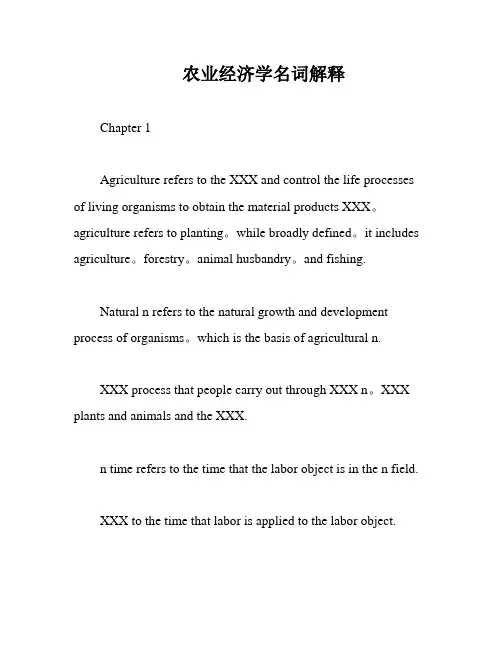
农业经济学名词解释Chapter 1Agriculture refers to the XXX and control the life processes of living organisms to obtain the material products XXX。
agriculture refers to planting。
while broadly defined。
it includes agriculture。
forestry。
animal husbandry。
and fishing.Natural n refers to the natural growth and development process of organisms。
which is the basis of agricultural n.XXX process that people carry out through XXX n。
XXX plants and animals and the XXX.n time refers to the time that the labor object is in the n field.XXX to the time that labor is applied to the labor object.XXX decreases。
XXX's expenses increases。
while as the household's e increases。
XXX.XXX agriculture refers to the non-XXX。
social。
XXX.Clark'XXX with lower per capita nal e。
the n of agricultural labor force in the total labor force is greater。
environmental and resource economics的ajg评级环境与资源经济学(Environmental and Resource Economics)是一门研究环境与资源经济学(Environmental and Resource Economics)是一门研究环境问题和资源利用的经济学分支。
它关注的核心问题是如何在保护环境和合理利用资源的前提下实现经济的可持续发展。
在学术界,环境与资源经济学的研究通常被分为不同的领域和主题,如气候变化、能源政策、水资源管理等。
为了评估这些领域的研究质量和影响力,学术期刊通常会对发表的文章进行评级。
AJG(Agricultural Economics)是农业经济学领域的一个知名期刊,但它并不专门针对环境与资源经济学。
然而,我们可以从以下几个方面来分析环境与资源经济学的研究质量和影响力:1. 发表文章的数量和质量:一个领域的研究质量和影响力可以从其发表的文章数量和质量来衡量。
如果一个领域的文章数量较多,且质量较高,那么这个领域的研究就具有较高的影响力。
你可以通过查阅相关领域的顶级期刊,如《Environmental and Resource Economics》、《Journal of Environmental Economics and Management》等,来了解该领域的研究动态。
2. 研究方法和数据:环境与资源经济学的研究通常涉及复杂的数学模型和大量的实证数据。
一个领域的研究质量和影响力可以从其使用的研究方法和数据来衡量。
如果你发现一个领域的研究方法较为先进,且数据来源可靠,那么这个领域的研究就具有较高的价值。
3. 研究成果的应用:环境与资源经济学的研究成果通常可以为政策制定者提供有益的参考。
一个领域的研究成果的应用程度可以从其对政策制定的影响来衡量。
如果你发现一个领域的研究成果能够为政策制定者提供有益的参考,并在实践中取得良好的效果,那么这个领域的研究就具有较高的价值。
矿产资源开发利用方案编写内容要求及审查大纲
矿产资源开发利用方案编写内容要求及《矿产资源开发利用方案》审查大纲一、概述
㈠矿区位置、隶属关系和企业性质。
如为改扩建矿山, 应说明矿山现状、
特点及存在的主要问题。
㈡编制依据
(1简述项目前期工作进展情况及与有关方面对项目的意向性协议情况。
(2 列出开发利用方案编制所依据的主要基础性资料的名称。
如经储量管理部门认定的矿区地质勘探报告、选矿试验报告、加工利用试验报告、工程地质初评资料、矿区水文资料和供水资料等。
对改、扩建矿山应有生产实际资料, 如矿山总平面现状图、矿床开拓系统图、采场现状图和主要采选设备清单等。
二、矿产品需求现状和预测
㈠该矿产在国内需求情况和市场供应情况
1、矿产品现状及加工利用趋向。
2、国内近、远期的需求量及主要销向预测。
㈡产品价格分析
1、国内矿产品价格现状。
2、矿产品价格稳定性及变化趋势。
三、矿产资源概况
㈠矿区总体概况
1、矿区总体规划情况。
2、矿区矿产资源概况。
3、该设计与矿区总体开发的关系。
㈡该设计项目的资源概况
1、矿床地质及构造特征。
2、矿床开采技术条件及水文地质条件。
《农业经济管理学》课程教学大纲Agricultural Economic and Management一、课程基本信息(一)知识目标:系统地了解农业经济管理学的基础理论知识及相关农业经济管理知识。
(二)能力目标:具备农业经济管理学基本理论、方法和技能,认真分析农业经济管理历史,深入研究我国改革开放以来农业经济管理面临的各种现实问题,努力探索农业经济管理发展规律。
(三)素质目标:具有创新精神,具备自主学习能力和一定的科研能力,成为从事农业经济管理工作的应用型、复合型人才。
三、基本要求(一)了解农业经济管理学的基本概念、基本原理和基本方法,能用这些原理与方法分析和解决农业经济管理发展中的现实问题。
(二)理解农业经济学与农业经济管理学的关系以及农村社会成员内部的关系。
(三)掌握农业经济形成、发展、变迁的规律以及农业经济和整个农村社会良性运行协调发展的内在机理,为农村社会协调发展贡献自己的力量。
四、教学内容与学时分配第一章绪论4学时第一节农业的起源与演进1学时知识点:1.农业的概念与内涵2. 中国原始农业的形成3. 中国农业历史发展的五个阶段第二节中国古代传统农业管理思想与实践0.5学时知识点:1.中国古代农业管理思想2.中国传统农业管理的特点3.古代传统农业的管理实践第三节中国近代农业经济0.5学时知识点: 1. 半殖民地半封建社会生产关系对农业发展的桎梏2.现代农业的萌芽与乡村建设实验第四节社会主义农业经济1学时知识点: 1. 土地改革2. 农业合作化3. 农村人民公社化4. 农村经济体制改革5. 农业经济大发展第五节农业在国民经济中的地位和作用0.5学时知识点: 1. 农业的本质与特点2. 农业在国民经济中的地位和作用3. 农业与国民经济其他部门的关系第六节农业经济管理学的研究对象、任务和方法0.5学时知识点: 1. 农业经济管理学的性质2. 农业经济管理学的研究对象3. 农业经济管理学的研究任务4. 农业经济管理学的研究方法本章小结:本章介绍了农业的起源与演进,重点讲解了中国古代传统农业管理思想与实践,在此基础上阐述中国近代农业经济概况。
农业科学英语词汇大全了解农业科学领域的专业术语和农作物种植英文表达农业科学英语词汇大全:了解农业科学领域的专业术语和农作物种植英文表达农业科学是研究农业生产和农村发展的学科领域,涉及到农作物种植、畜牧、农业工程等各个方面。
在农业科学的学习和研究中,掌握相关的英语词汇对于与国际合作、学术交流以及阅读外文文献都非常重要。
下面是一个农业科学英语词汇大全,旨在帮助你扩展农业科学领域的英语词汇量。
一、农作物种植1. Crops - 农作物2. Cultivation - 种植3. Plants - 植物4. Seeds - 种子5. Soil - 土壤6. Irrigation - 灌溉7. Fertilizer - 肥料8. Pesticide - 农药9. Harvest - 收获10. Yield - 产量二、农业工程1. Machinery - 机械设备2. Tractor - 拖拉机3. Harvester - 收割机4. Seeder - 播种机5. Sprayer - 喷雾器6. Greenhouse - 温室7. Irrigation system - 灌溉系统8. Crop rotation - 农作物轮作9. Biotechnology - 生物技术10. Genetic engineering - 基因工程三、农业生产与管理1. Agriculture - 农业2. Farm - 农场3. Farmer - 农民4. Livestock - 畜牧5. Animal husbandry - 养殖业6. Organic farming - 有机农业7. Agricultural economics - 农业经济学8. Agricultural extension - 农业推广9. Agricultural research - 农业研究10. Sustainable agriculture - 可持续农业四、农产品加工1. Food processing - 食品加工2. Dairy products - 乳制品3. Meat processing - 肉类加工4. Canning - 罐头5. Freezing - 冷冻6. Fermentation - 发酵7. Milling - 粉磨8. Packaging - 包装9. Quality control - 质量控制10. Food safety - 食品安全五、农业市场与贸易1. Market - 市场2. Export - 出口3. Import - 进口4. Trade - 贸易5. Price - 价格6. Demand - 需求7. Supply - 供应8. International trade - 国际贸易9. Agricultural subsidies - 农业补贴10. Agricultural policy - 农业政策六、环境与可持续发展1. Sustainable development - 可持续发展2. Environmental protection - 环境保护3. Climate change - 气候变化4. Renewable energy - 可再生能源5. Conservation - 保护6. Ecosystem - 生态系统7. Biodiversity - 生物多样性8. Pollution - 污染9. Soil erosion - 土壤侵蚀10. Water conservation - 水资源保护以上是农业科学英语词汇大全,涵盖了农作物种植、农业工程、农业生产与管理、农产品加工、农业市场与贸易以及环境与可持续发展等多个方面的专业术语。
农业刊物的影响因子农业刊物的影响因子(Impact Factor)是衡量期刊影响力的指标之一,能够反映期刊文章被引用的频率。
影响因子是由科学引文索引(SCI,Science Citation Index)根据期刊文章的引用情况进行计算的。
影响因子的计算方式是在其中一特定年度内,该期刊的引用总数(包括自引和他引)除以该年度该期刊发表的论文数量。
例如,影响因子为2的期刊表示在一年期间,该期刊的所有论文平均被引用了2次。
影响因子的数值越高,代表着该期刊在学术界的影响力越大。
因此,影响因子是评估期刊重要性和质量的重要指标。
一般来说,领域内知名期刊的影响因子较高,有更多的学术机构和学者愿意投稿,也能吸引更多学者关注和引用。
农业领域的期刊涵盖了农业科学、农业工程、农学、畜牧学、兽医学、农业经济学等多个子领域。
以下是几个农业领域的重要期刊的影响因子示例:1. Journal of Agricultural and Food Chemistry该期刊发表有关农业和食品化学的研究成果。
它是食品科学和技术领域的主要期刊之一,由美国化学学会出版。
其影响因子在过去几年持续增长,目前已达到4.192(2024年数据)。
2. Crop ScienceCrop Science是美国作物学会(Crop Science Society of America)的官方期刊,发表作物学和农业科学的研究。
该期刊在作物学领域享有盛誉,其影响因子为2.446(2024年数据)。
3. Field Crops ResearchField Crops Research是国际田间作物研究杂志,涵盖了农业植物科学、作物生长和发展、农业系统和农业经济等领域。
该期刊的影响因子为4.406(2024年数据)。
4. Journal of Animal ScienceJournal of Animal Science是美国动物科学学会(American Society of Animal Science)的官方期刊,发表有关动物科学和畜牧学的研究。
agriculture 的读法、释义和用法
Agriculture的读法、释义和用法
读法:Agriculture的发音为英式音标/ˈæɡrɪ.kʌl.tʃə(r)/和美式音标/ˈæɡrɪˌkʌltʃɚ/。
注意将重音放在第一个音节“agri”上,并保持元音“a”和“u”的清晰发音,同时“culture”部分发音为/ˈkʌlt ʃər/或/ˈkʌltʃɝ/。
释义:Agriculture的基本意思是“农业”,它涵盖了栽培农作物、饲养牲畜、林业和农村副业等生产事业。
此外,它也可以指研究农业生产的科学或艺术,包括作物栽培、育种、土壤管理、气象学、肥料使用和农业病虫害等方面。
用法:
1.作为名词:Agriculture通常被视作不可数名词,表示农业的整体概念。
例如,“Agriculture is an important part of our economy.”(农业是我们经济的重要组成部分。
)
2.派生词:从agriculture这个词根可以派生出其他词汇,如“agricultural”(农业的,农艺的)和“agriculturist”(农学家,农场工作者)。
3.语境应用:在讨论农业生产、农业政策、农业技术或农业经济学等话题时,agriculture是一个常用的术语。
总之,Agriculture是一个描述农业生产和相关科学的词汇,它在日常语境和学术讨论中都有着广泛的应用。